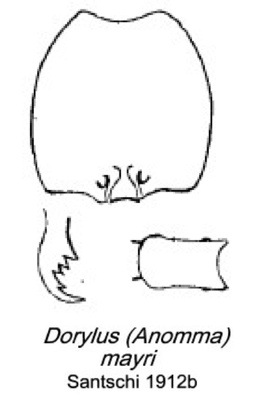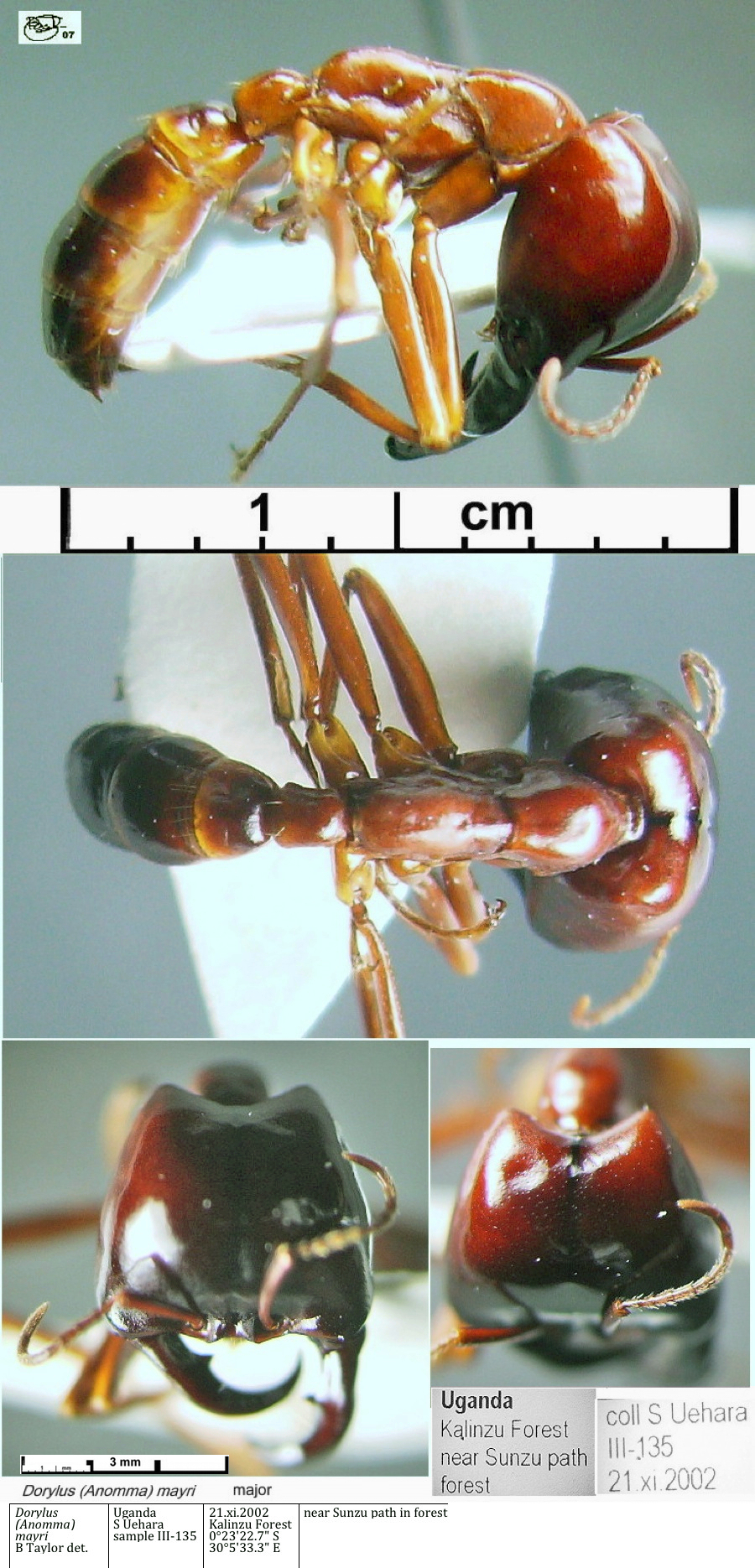Dorylus (Anomma) mayri Santschi
  Type locality Cameroun
(Dorylus (Anomma) Mayri n.
sp., Santschi, 1912b: 159, illustrated, worker) no location; worker
only
known (see Bolton, 1995) Type locality Cameroun
(Dorylus (Anomma) Mayri n.
sp., Santschi, 1912b: 159, illustrated, worker) no location; worker
only
known (see Bolton, 1995)  . .
|
 Santschi's (1912b)
description is at Santschi's (1912b)
description is at  - he emphasised that he
probably had not
seen the major or soldier, hence his image, of a 10 mm worker, has to
be regarded with caution (I would not expect to see the extra teeth on
the mandibles if it were a major). - he emphasised that he
probably had not
seen the major or soldier, hence his image, of a 10 mm worker, has to
be regarded with caution (I would not expect to see the extra teeth on
the mandibles if it were a major).
Raignier & van Boven (1955) cite Santschi's original
description from 3 specimens from Cameroun (passed to him by Emery,
from Mayr). Santschi thought of it as a cousin of arcens but
probably with a very large worker.
The key features are - antennal scape long and slender
(width no more than 20% of length); petiole posterior no wider than
anterior and twice as long as wide (as in wilverthi, although
that has a petiole which is slightly wider posteriorly) rounded
ventro-posterior teeth.
|
 Polymorphism Polymorphism
The photomontages are of specimens collected in the
Kalinzu Forest, Uganda (sample III-135, 21.xi.2002; by Shigeo
Uehara). The major and other morphs, lacking the second media morph
that probably would have matched Santschi's description (above), are
shown on the polymorphism montage. The major morph is very large as
predicted by Santschi.
The various morphs are shown in detail on the Dorylus (Anomma) mayri
morphs page.
|
 Full
new description - Uehara III-135 Full
new description - Uehara III-135
Overall - shiny matt mostly yellow brown, with apex of head and
mandibles much darker, also dark on much of the gaster brown with
distinct yellow brown apical bands to each tergite; yellow brown
scapes, funiculi and legs
TL 13.1 HW 4.10 HL 3.60 HD 2.75 CI SL 1.2 SI AL 4.0 PW 1.1 PetL 1.0 GL
4.50 MFL 3.0
Head - trapezoid, widest pre-anterior, posterior little more than 1/2
as wide, sides weakly convex, rear third more convex and angled inward;
posterior margin quite deep scallop, with very slight median outward
bump, posterolateral angles sharp; sculpturation of extremely fine
spiculation, almost effaced on posterior half of face, which has very
minute and very sparse hair pits; median line always visible, clearly
impressed in anterior third; clypeal margin a concave arc, with frontal
carinae giving rise to distinct anterior points; median hair, very fine
pair away from midpoint; mandible polished, very long but quite thick
with a moderate basal tooth, hardly visible hair pits; scape very
short, not reaching sides of head when directed laterally, moderately
thick, broadening from base to apex, near smooth; funiculus segments
progressively lengthening and widening; apex no more than 1/3 longer
than 9; head in profile very bulbous, posterior corners fairly acute
angles; hairs barely visible @ 32x.
Alitrunk - in profile a shallow dome; distinct and shallowly convex
"saddle"; spiracle an angled oval rearward facing with top more forward
than bottom; dorsum of propodeum long slightly convex and lower at
posterior, declivity short and vertical with incurve at bottom;
metapleural gland with upper margin distinctly longer than lower; all
over very fine spiculation; hairs none.
Petiole - moderately long, flat dorsum, posterior face vertical but not
in turned; dorsum first two-thirds parallel sides then widening front
to back; posterior ventral processes well devoloped; spiracle small but
distinctly raised; subpetiolar process a quite small triangle;
sculpturation as alitrunk; pair of hairs on posterior dorsum, several
hairs below.
Gaster - first segment much narrow anteriorly, sternite with notches to
accomodate postero-lateral processes of petiole; all segments shiny;
hairs sparse on posterior margins but long fringe on posterior of first
tergite; very short and sparse pilosity on apical two segments.
Legs - coxae moderately long but more rounded outer surface; femora
broad, without spiculation; tibiae moderately wide, almost no pilosity;
tarsae long and slender, finely bristly, large claws.
|